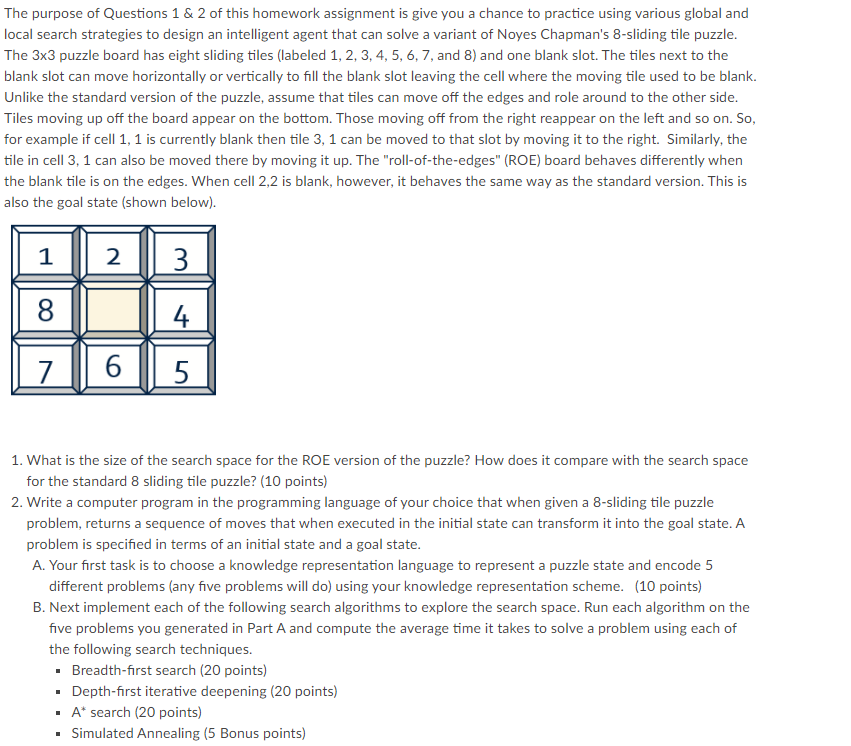Answered step by step
Verified Expert Solution
Question
1 Approved Answer
i need help with 2 The purpose of Questions 1 & 2 of this homework assignment is give you a chance to practice using various

i need help with 2
The purpose of Questions 1 & 2 of this homework assignment is give you a chance to practice using various global and local search strategies to design an intelligent agent that can solve a variant of Noyes Chapman's 8-sliding tile puzzle. The 3x3 puzzle board has eight sliding tiles (labeled 1, 2, 3, 4, 5, 6, 7, and 8) and one blank slot. The tiles next to the blank slot can move horizontally or vertically to fill the blank slot leaving the cell where the moving tile used to be blank. Unlike the standard version of the puzzle, assume that tiles can move off the edges and role around to the other side. Tiles moving up off the board appear on the bottom. Those moving off from the right reappear on the left and so on. So, for example if cell 1, 1 is currently blank then tile 3, 1 can be moved to that slot by moving it to the right. Similarly, the tile in cell 3, 1 can also be moved there by moving it up. The "roll-of-the-edges" (ROE) board behaves differently when the blank tile is on the edges. When cell 2,2 is blank, however, it behaves the same way as the standard version. This is also the goal state (shown below). 1 2 3 8 4 7 6 || 5. 1. What is the size of the search space for the ROE version of the puzzle? How does it compare with the search space for the standard 8 sliding tile puzzle? (10 points) 2. Write a computer program in the programming language of your choice that when given a 8-sliding tile puzzle problem, returns a sequence of moves that when executed in the initial state can transform it into the goal state. A problem is specified in terms of an initial state and a goal state. A. Your first task is to choose a knowledge representation language to represent a puzzle state and encode 5 different problems (any five problems will do) using your knowledge representation scheme. (10 points) B. Next implement each of the following search algorithms to explore the search space. Run each algorithm on the five problems you generated in Part A and compute the average time it takes to solve a problem using each of the following search techniques. Breadth-first search (20 points) Depth-first iterative deepening (20 points) At search (20 points) Simulated Annealing (5 Bonus points) . The purpose of Questions 1 & 2 of this homework assignment is give you a chance to practice using various global and local search strategies to design an intelligent agent that can solve a variant of Noyes Chapman's 8-sliding tile puzzle. The 3x3 puzzle board has eight sliding tiles (labeled 1, 2, 3, 4, 5, 6, 7, and 8) and one blank slot. The tiles next to the blank slot can move horizontally or vertically to fill the blank slot leaving the cell where the moving tile used to be blank. Unlike the standard version of the puzzle, assume that tiles can move off the edges and role around to the other side. Tiles moving up off the board appear on the bottom. Those moving off from the right reappear on the left and so on. So, for example if cell 1, 1 is currently blank then tile 3, 1 can be moved to that slot by moving it to the right. Similarly, the tile in cell 3, 1 can also be moved there by moving it up. The "roll-of-the-edges" (ROE) board behaves differently when the blank tile is on the edges. When cell 2,2 is blank, however, it behaves the same way as the standard version. This is also the goal state (shown below). 1 2 3 8 4 7 6 || 5. 1. What is the size of the search space for the ROE version of the puzzle? How does it compare with the search space for the standard 8 sliding tile puzzle? (10 points) 2. Write a computer program in the programming language of your choice that when given a 8-sliding tile puzzle problem, returns a sequence of moves that when executed in the initial state can transform it into the goal state. A problem is specified in terms of an initial state and a goal state. A. Your first task is to choose a knowledge representation language to represent a puzzle state and encode 5 different problems (any five problems will do) using your knowledge representation scheme. (10 points) B. Next implement each of the following search algorithms to explore the search space. Run each algorithm on the five problems you generated in Part A and compute the average time it takes to solve a problem using each of the following search techniques. Breadth-first search (20 points) Depth-first iterative deepening (20 points) At search (20 points) Simulated Annealing (5 Bonus points)
Step by Step Solution
There are 3 Steps involved in it
Step: 1

Get Instant Access to Expert-Tailored Solutions
See step-by-step solutions with expert insights and AI powered tools for academic success
Step: 2

Step: 3

Ace Your Homework with AI
Get the answers you need in no time with our AI-driven, step-by-step assistance
Get Started


